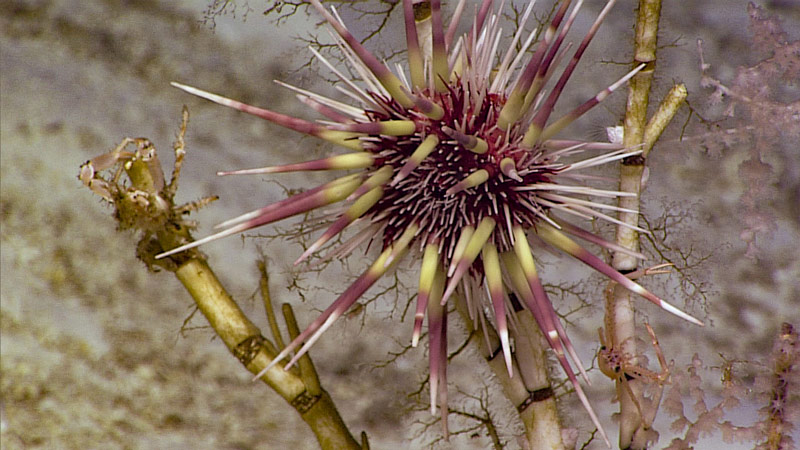
An urchin climbs up the dead skeleton of a bamboo coral. Image courtesy of the NOAA Office of Ocean Exploration and Research, Deepwater Wonders of Wake. Download larger version (jpg, 1.2 MB)

An urchin climbs up the dead skeleton of a bamboo coral. Image courtesy of the NOAA Office of Ocean Exploration and Research, Deepwater Wonders of Wake. Download larger version (jpg, 1.2 MB)
Dive 12: Coronate Medusa
This red jelly was seen dancing through the water column during exploration of a guyot located approximately 70 miles southwest of Wake Island at a depth of approximately 1,260 meters. Video courtesy of the NOAA Office of Ocean Exploration and Research, Deepwater Wonders of Wake. Download larger version (mp4, 82.9 MB).
Today's dive was on a guyot located approximately 70 miles southwest of Wake Island and was unofficially dubbed "Revolver Seamount." The objective of the dive was to survey a volcanic cone located on the flat summit of the seamount. The current thinking is that these could have formed as a result of rejuvenated volcanism (after the seamount formed a coral reef on top). The vehicles reached the bottom at a depth of 1,266 meters. The dive track ran along the crest of the cone that is situated on the southeastern edge of the guyot top, and the cone appears to have partly slumped down the edge of the guyot. Given the cone's location on top of the presumed carbonate and/or pelagic sediment platform, erosion and sedimentary processes occurred prior to the cone's eruption. Therefore, it is presumed to represent post-erosional (or rejuvenated) volcanism. At the landing site, the seafloor appeared to consist of manganese-coated cobbles and boulders, possibly representing pillow lavas, with a few small pockets of little sand. Right at the landing site, a loose angular rock (instead of the rounder, larger pillow shapes) was collected, which in the lab appears to contain fragments of carbonate and potentially volcanoclastic material.
Although today's dive was in a depth that we considered optimal for animals, the density was low but the diversity was relatively high. Sponges included species in the genera Walteria, Dictyaulus, Poliopogon, Farrea, Bolosoma, Tretopleura, Atlantisella, and Saccocalyx. Coral genera included Paragorgia, Hemicorallium, Narella, Calyptrophora, Victorgorgia, Paramuricea, Iridogorgia, Acanthogorgia, and Trissopathes. Arthropods and echinoderms included shrimp, a polychelid lobster, a crab carrying a single anemone, various seastars, crinoids (all of which were feather stars). Fish were present as well, mainly eels that included an unusual synaphobranchid or possibly the juvenile phase of something well known, a sorceress eel, rat tails, cusk eels, and tripod fish.